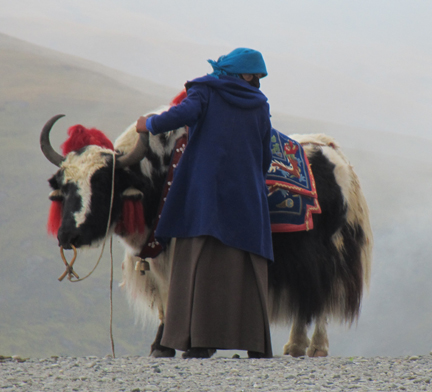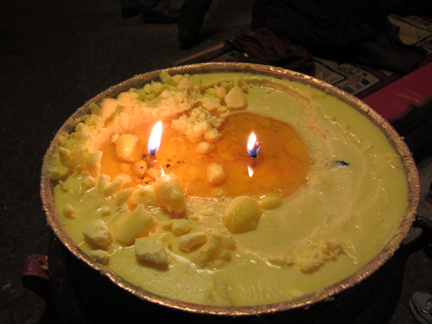Standing on the Roof of the World
And just to ease your fears, no I didn’t use a ladder to get here. The time in Tibet has been wonderful. After the usual delay for the flight from Chengdu to Lhasa we arrived and met our local guide, Pema. The first night we spent in a small town called Tse Tang. On the way there we stopped in a small village the visited a local home. Pema explained that he picks different families all the time, so they don’t get jaded with visitors. The grandmother was carrying the granddaughter on her back while she fixed us some butter tea and bread. The butter tea is: Yak butter, a little tea leaf, hot water and salt. It was not greasy, but kind of “earthy” tasting. Pema said the nomads average 40 cups a day. I don’t think I could do that much, though it wasn’t so bad. They use Yak butter for tea, cooking, eating and to fuel candles. The Tibetans smile a lot and are happy to respond to and offer up “Tash delay” which is “hello”. Pema told us that if one knocks on a door in a village they will just invite you in and feed you. The hotel was fine, and the next morning we visited a local Temple/Monastery. After that we had a three hour bus ride and up a seriously winding switchback road to Khampa La (La means pass) at 15,700 feet for a scenic view of a beautiful lake. I passed on the “get your picture on a Yak”. I did use the public toilet there and it was a transcendental experience, though not in a particularly good way, the odor was something to behold, and that kind of altitude does have an effect. Then we had the three hour ride back to Lhasa the capital and largest city in Tibet.
It is interesting to be in a place where the signs are in Chinese and Tibetan but not any English. I went to the ATM and then the bank to get smaller notes, and it was fun using sign language to explain that. Monday was a busy day, we visited the Jokhang Temple which is considered the holiest temple in Tibet and walked around the “Barkhor” or Pilgrim’s Circuit. Pema explained that some Tibetans do a Prostrate Pilgrimage to this temple from their home city. That involves a mantra while stretching out prostrate and then walking as far as you reached and doing it again. It can take from one to two years to accomplish. Once they arrive at the temple they go around it three times on the Barkor and then go inside and finish in front of an original 7th century statue of Buddha Shakyamuni (Siddhartha Gautama). This is one of two statues that the Tibetan king received as dowry from his Chinese Princess and Nepalese Princess wife.
The spirituality in Tibet is palpable. Not to say that ALL the people are deeply into their faith, but enough are that you feel it in the air. Many monks, people with prayer wheels, prayer flags everywhere and a general sense of calm and peace. At the temples there are monks and artists working on Thangka, which are multilayered usually religious paintings. The minute detail is unbelievable. It might take a year or more for a single painting. The insides of the temples are very ornately decorated, and every inch is covered with paintings, cloths, and statues. There are always many people prostrating and praying, chanting mantras. The statues are of the incarnations of the Dalai Lama and of Buddha and various Buddhist deities.
After lunch we went on to the Potala Palace. It was originally built in the 7th century by Songtsen Gampo and then taken over by the fifth incarnation of the Dalai Lama who ended the civil war and unified the Tibetan People. Every incarnation of the Dalai Lama lived there up until the current (14th) fled Tibet in 1959. The palace was slowly destroyed by natural forces and earthquakes until it was rebuilt on a more solid foundation in the 17th Century. The place is quite large and impressive. 380 steps to climb up which at 11,700 feet altitude is a bit of a challenge. The inside of the Potala was spectacular. No pictures are allowed inside, but let me tell you it is something. Room after room of statues and holy books and chapels. Mostly gold or silver, wood covered in carvings, stone with gems, all very old and with history behind them. The bodies of several of the previous incarnations of the Dalai Lama are in crypts along with many of their belongings. The fifth Dalai Lama’s crypt is 500 kilograms of gold, the 13th I think it was, is nearly 4000 kilograms of gold. They have many, many bowls of Yak butter with wicks in them burning and the Tibetans place Yak butter donations into them and money donations in piles at various statues while they pray.
I have to say that Tibet is the highlight of the China trip and maybe the whole trip. It was a chance to see some real people who live a very different life and not to feel like I was going to a Disney show put on for the tourists. The Tibetans see us watching them, but weren’t putting on a “traditional ceremony” for us.
Tags: Travel




September 26th, 2011 at 2:50 pm
Jim, what a wonderful time i am having sharing your travels. Although not there with you i sometimes feel that i am, your blog is so well writtern, intesrting, thought provoking and a pleasure to read. I hope you are well and have a great time with Dan in japan. Hang on in there…Robbie
October 5th, 2011 at 6:37 pm
Books; They have Books? Maybe I’ll check it out.